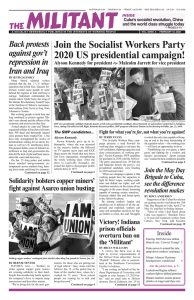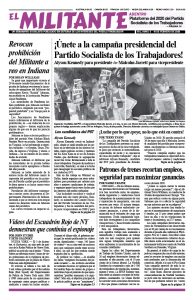Many liberal editorial writers claimed that the Jan. 2 U.S. military operation that killed Gen. Qassem Soleimani would cause people to unite behind the regimes in Iran and Iraq in outrage. Soleimani commanded the Iranian rulers’ Quds Force, the wing of the Islamic Revolutionary Guard Corps at the forefront of Tehran’s reactionary interventions from Syria to Iraq, from Lebanon to Yemen.
But working people in both Iran and Iraq continued to protest against Tehran’s wars abroad and the effects of the economic and social crisis they face.
Armed attacks by cops and Tehran-organized militias in Iraq have left more than 500 dead and thousands injured since protests there erupted Oct. 1, but have only strengthened the resolve of demonstrators calling for an end to Iranian as well as U.S. interference there. The protests follow years of Tehran’s interference in Iraq and government disdain for the lack of jobs and basic necessities like water and electricity.
On Jan. 25 Iraqi police and militia forces attacked anti-government encampments across southern Iraq, burning down tents and firing live ammunition. Cops arrested 16 protesters in Basra and killed at least one near Tahrir Square in Baghdad and three in the southern city of Nasiriyah.
The attacks took place the day after a march organized by Muqtada al-Sadr, in Baghdad, calling for the expulsion of U.S. troops. Al-Sadr, a Shiite politician with past connections with the clerical leaders in Iran, heads the largest electoral bloc in the Iraqi parliament and commands his own armed militias.
On Jan. 26 thousands of students and workers converged on Baghdad’s Tahrir Square to protest the government’s assault and reestablish the camp there.
Al-Sadr claims he sympathizes with the Tahrir Square protesters. But after the drone strike that killed Soleimani, he met with leaders of the reactionary regime in Iran. He then returned to Baghdad and called on anti-government protesters in Tahrir Square to join his Jan. 24 march against the U.S. troops in Iraq.
But most anti-government protesters refused to drop their demands for an end to Tehran’s violations of Iraqi sovereignty.
“If Muqtada asks for the exit of the Americans and nonintervention, he should raise the same slogan against Iranian interference,” protester Yahya Mohammed told The Associated Press. Militias organized by the Iranian rulers have been at the forefront of the murderous assaults on Iraqi anti-government protests.
Washington meanwhile has increased its troops in the Mideast by more than 20,000 since last spring.
Al-Sadr tweeted his “disappointment” with the Tahrir Square protesters for not joining his march and instructed his followers — some of whom had set up tents in the anti-government protests — to abandon the encampments. This opened the door for security forces’ assaults.
Sadr supporters’ “withdrawal has achieved the opposite effect of breaking up the movement,” Abu Siwar, a demonstrator in Tahrir Square, told Al Jazeera. “We have had more protesters joining in.”
No justification for Tehran’s repression
Protests also spread widely in Iran, after the regime first lied, then admitted that it “accidentally” shot down a Ukrainian passenger plane Jan. 8 killing all 176 on board.
The regime in power in Tehran spearheaded the counterrevolution that pushed back many advances made by working people during the 1979 Iranian Revolution. That upheaval was a deep-going, modern, popular social revolution that overthrew the U.S.-backed shah, won rights for women and oppressed nationalities and led workers to form workers councils in the factories and fields to press their demands.
Soleimani emerged as a Revolutionary Guard leader, as a combatant in the counterrevolutionary assaults, starting with leading bloody attacks against Iranian Kurds fighting for their national rights.
Students at the Amir Kabir Polytechnic University in Tehran issued a statement Jan. 11 stating that “the presence of the United States in the Middle East has done nothing but sow chaos and disorder.” Nonetheless, the students said, “U.S. adventurism in the region cannot be an excuse to justify domestic repression.”
The students lauded the demonstrations against Tehran’s interventions abroad and anti-worker measures at home that swept the country in November — sparked when fuel prices were tripled. Those actions were more extensive than the protests there in 2018, and echoed many of the demands chanted at those actions, including opposition to Tehran’s military intervention. The Iranian rulers’ wars are aimed at extending their power across the region and the deadly consequences fall overwhelmingly on working people.
“The only way out of our current predicament is the simultaneous rejection of both domestic despotism and imperial arrogance,” the students said.
According to reports there were more than 3,500 protests in Iran in 2019, mostly by workers and farmers. Demands ranged from opposing cuts in pensions, to water rights for farmers, aid to flood victims and for an end to the regime’s wars abroad.
On Nov. 13, some 1,000 workers demanded unpaid wages at the sugar mill in Haft Tapeh, in Khuzestan province in the southwestern part of Iran, home to the country’s Arab minority, which faces widespread discrimination in hiring.
In Mahshahr, Arab farmers — who lost access to water for irrigation when a dam was built — blockaded the roads to oil refineries and were brutally attacked by the Revolutionary Guard on Nov. 18. As many as 100 people were killed.
The government attacks on the protests in November failed to crush the spirit of working people.
At the beginning of January, workers at the Zarand Minerals Company in Kerman in central Iran stopped work to protest the company’s intention to change their employment status from permanent to temporary.
Tens of thousands of workers went back onto the streets after the Ukrainian plane was shot down, by not one but two Revolutionary Guard missiles.
Like in Iraq, many working people and youth are repelled by what Soleimani represents. Protesters in Tabriz, a city in the north west mostly populated by Azerbaijanis, in Tehran and other cities tore down posters of Soleimani, put up after his death.
Recognizing the widespread sentiment against the regime, Soleimani’s family was quoted in the Iranian press, saying they “forgive” a teenager arrested for tearing down the general’s photo and asked that the youth not be prosecuted.


